999
Lemme help you murder that paper :)
Nursing, Math, Biology, Anatomy etc
- 3223
- 0
- 158
Community
- Followers
- Following
186 Reviews received
3395 items
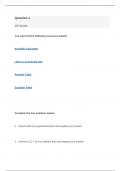
CHEM 121 Exam 1 SPRING 2024 Portage learning
Complete the two problems below: 1. Convert 845.3 to exponential form and explain your answer. 2. Convert 3.21 x 10-5 to ordinary form and explain your answer. Your Answer: 8.453x10^2 - the decimal point was moved two places to the left - the first number was 8 .0000321 - the decimal point needed to be moved five spaces to the left. 1. Convert 845.3 = larger than 1 = positive exponent, move decimal 2 places = 8.453 x 102 2. Convert 3.21 x 10-5 = negative exponent = smaller than 1, move ...
- Exam (elaborations)
- • 17 pages •
Complete the two problems below: 1. Convert 845.3 to exponential form and explain your answer. 2. Convert 3.21 x 10-5 to ordinary form and explain your answer. Your Answer: 8.453x10^2 - the decimal point was moved two places to the left - the first number was 8 .0000321 - the decimal point needed to be moved five spaces to the left. 1. Convert 845.3 = larger than 1 = positive exponent, move decimal 2 places = 8.453 x 102 2. Convert 3.21 x 10-5 = negative exponent = smaller than 1, move ...
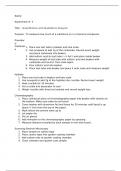
CHEM 121 Lab 3 Quantitative and Qualitative Analysis SPRING 2024 Portage learning
Title: Quantitative and Qualitative Analysis Purpose: To measure how much of a substance is in a chemical compound. Procedure: Carbonate 1. Place one test tube in beaker and tare scale. 2. Use scoopula to add 1g of the carbonate. Record exact weight and place carbonate into beaker. 3. Add sulfuric acid to test tube (~⅓ full ) and place inside beaker 4. Measure weight of test tube with sulfuric acid and beaker with carbonate and record. Tare scale again. 5. Pour sulfuric acid into bea...
- Package deal
- Other
- • 5 pages •
Title: Quantitative and Qualitative Analysis Purpose: To measure how much of a substance is in a chemical compound. Procedure: Carbonate 1. Place one test tube in beaker and tare scale. 2. Use scoopula to add 1g of the carbonate. Record exact weight and place carbonate into beaker. 3. Add sulfuric acid to test tube (~⅓ full ) and place inside beaker 4. Measure weight of test tube with sulfuric acid and beaker with carbonate and record. Tare scale again. 5. Pour sulfuric acid into bea...
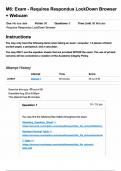
MATH 110 Module 6 exam Portage learning SPRING 2024
A new drug is introduced that is supposed to reduce fevers. Tests are done with the drug. The drug is given to 60 people who have fevers. It is found that the mean time that it takes for the fever to get back to normal for this test group is 350 minutes with a standard deviation of 90 minutes. Find the 80% confidence interval for the mean time that the drug will take to reduce all fevers for all people. Answer the following questions: 1. Multiple choice: Which equation would you use to so...
- Exam (elaborations)
- • 13 pages •
A new drug is introduced that is supposed to reduce fevers. Tests are done with the drug. The drug is given to 60 people who have fevers. It is found that the mean time that it takes for the fever to get back to normal for this test group is 350 minutes with a standard deviation of 90 minutes. Find the 80% confidence interval for the mean time that the drug will take to reduce all fevers for all people. Answer the following questions: 1. Multiple choice: Which equation would you use to so...
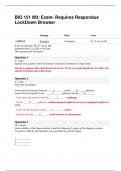
BIOD 151 Module 3 exam SPRING 2024 Portage learning
Explain why a patient with liver disease would have intolerance to fatty foods. The liver produces bile which breaks down fats. If it is not producing bile (or less bile), fats will not be broken down effectively. Question 2 5 / 5 pts Fill in the four blanks: Food enters the stomach from the ____A_______ via the ____B______ sphincter. Food exits the stomach via the ______C______ sphincter into the____D_______. - Food enters the stomach from the ______A_____ : esophagus - via the _____B_...
- Exam (elaborations)
- • 13 pages •
Explain why a patient with liver disease would have intolerance to fatty foods. The liver produces bile which breaks down fats. If it is not producing bile (or less bile), fats will not be broken down effectively. Question 2 5 / 5 pts Fill in the four blanks: Food enters the stomach from the ____A_______ via the ____B______ sphincter. Food exits the stomach via the ______C______ sphincter into the____D_______. - Food enters the stomach from the ______A_____ : esophagus - via the _____B_...

BIOD 151 A& P LAB 7 SPRING 2024 Portage learning
A&P LAB 4 1A-The Squamosal suture marks the division of which cranial bones? Temporal bone and Parietal bones 1B-The Lambdoidal suture marks the division of which cranial bones? Occipital bone and Parietal bones 2A-Which endocrine gland is situated in the cranial bone pictured above (highlighted in blue)? The pituitary gland is situated in the hypophyseal fossa of the sphenoid bone 2B- Which cranial bone is pictured above (highlighted in blue)? The ethmoid bone 3A-Which facial bone is...
- Other
- • 3 pages •
A&P LAB 4 1A-The Squamosal suture marks the division of which cranial bones? Temporal bone and Parietal bones 1B-The Lambdoidal suture marks the division of which cranial bones? Occipital bone and Parietal bones 2A-Which endocrine gland is situated in the cranial bone pictured above (highlighted in blue)? The pituitary gland is situated in the hypophyseal fossa of the sphenoid bone 2B- Which cranial bone is pictured above (highlighted in blue)? The ethmoid bone 3A-Which facial bone is...
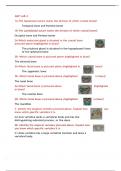
BIOD 151 A& P LAB 4 SPRING 2024 Portage learning
A&P LAB 4 1A-The Squamosal suture marks the division of which cranial bones? Temporal bone and Parietal bones 1B-The Lambdoidal suture marks the division of which cranial bones? Occipital bone and Parietal bones 2A-Which endocrine gland is situated in the cranial bone pictured above (highlighted in blue)? The pituitary gland is situated in the hypophyseal fossa of the sphenoid bone 2B- Which cranial bone is pictured above (highlighted in blue)? The ethmoid bone 3A-Which facial bone is...
- Other
- • 4 pages •
A&P LAB 4 1A-The Squamosal suture marks the division of which cranial bones? Temporal bone and Parietal bones 1B-The Lambdoidal suture marks the division of which cranial bones? Occipital bone and Parietal bones 2A-Which endocrine gland is situated in the cranial bone pictured above (highlighted in blue)? The pituitary gland is situated in the hypophyseal fossa of the sphenoid bone 2B- Which cranial bone is pictured above (highlighted in blue)? The ethmoid bone 3A-Which facial bone is...
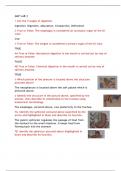
BIOD 151 A&P LAB 3 SPRING 2024 Portage learning
A&P LAB 3 1-List the 5 stages of digestion. Ingestion, Digestion, Absorption, Compaction, Defecation 2-True or False: The esophagus is considered an accessory organ of the GI tract. true 3-True or False: The tongue is considered a primary organ of the GI tract TRUE 4A-True or False: Mechanical digestion in the mouth is carried out by way of salivary amylase. FALSE 4B.True or False: Chemical digestion in the mouth is carried out by way of salivary amylase. TRUE 5-Which portion of th...
- Other
- • 3 pages •
A&P LAB 3 1-List the 5 stages of digestion. Ingestion, Digestion, Absorption, Compaction, Defecation 2-True or False: The esophagus is considered an accessory organ of the GI tract. true 3-True or False: The tongue is considered a primary organ of the GI tract TRUE 4A-True or False: Mechanical digestion in the mouth is carried out by way of salivary amylase. FALSE 4B.True or False: Chemical digestion in the mouth is carried out by way of salivary amylase. TRUE 5-Which portion of th...
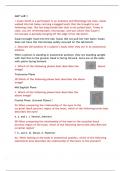
BIOD 151 A& P LAB 1 SPRING 2024 Portage learning
A&P LAB 1 1.Susan Smith is a participant in an Anatomy and Physiology lab class. Susan walked into lab today carrying a bagged lunch that she brought to eat following class. She has long blonde hair that is not pulled back. Today in class, you are reviewing basic microscopy, and you notice that Susan’s microscope is partially hanging off the edge of her lab bench. Susan brought food into the lab; Susan did not pull her hair back; Susan does not have the microscope safely secured on the ...
- Other
- • 3 pages •
A&P LAB 1 1.Susan Smith is a participant in an Anatomy and Physiology lab class. Susan walked into lab today carrying a bagged lunch that she brought to eat following class. She has long blonde hair that is not pulled back. Today in class, you are reviewing basic microscopy, and you notice that Susan’s microscope is partially hanging off the edge of her lab bench. Susan brought food into the lab; Susan did not pull her hair back; Susan does not have the microscope safely secured on the ...
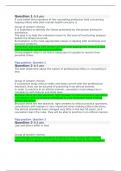
COUN 6100 Week 10 final exam ethics SPRING 2024
Question 1 0.5 pts A core belief that members of the counseling profession hold concerning helping others with their mental health concerns is Group of answer choices It is important to identify the illness presented by the person asking for assistance. The goal is to help the individual return to the level of functioning enjoyed before the illness occurred. Remediation is the most appropriate means in dealing with emotional and personal problems. Prevention and early intervention are ...
- Exam (elaborations)
- • 18 pages •
Question 1 0.5 pts A core belief that members of the counseling profession hold concerning helping others with their mental health concerns is Group of answer choices It is important to identify the illness presented by the person asking for assistance. The goal is to help the individual return to the level of functioning enjoyed before the illness occurred. Remediation is the most appropriate means in dealing with emotional and personal problems. Prevention and early intervention are ...
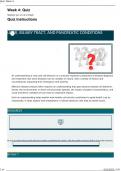
NRNP 6550 Quiz Week 4: LIVER, BILIARY TRACT, AND PANCREATIC CONDITIONS
An understanding of cells and cell behavior is a critically important component of disease diagnosis and treatment. But some diseases can be complex in nature, with a variety of factors and circumstances impacting their emergence and severity. Effective disease analysis often requires an understanding that goes beyond isolated cell behavior. Genes, the environments in which cell processes operate, the impact of patient characteristics, and racial and ethnic variables all can have an importa...
- Other
- • 5 pages •
An understanding of cells and cell behavior is a critically important component of disease diagnosis and treatment. But some diseases can be complex in nature, with a variety of factors and circumstances impacting their emergence and severity. Effective disease analysis often requires an understanding that goes beyond isolated cell behavior. Genes, the environments in which cell processes operate, the impact of patient characteristics, and racial and ethnic variables all can have an importa...

BIOD 101 Exam 1 portage learning
ECON 528 Final Exam (University of louisiana
CHEM 103 Module 5 Problem Set 2023 Portage learning
BIOD 101 Exam 1 portage learning
CHEM 121 Module 4 exam (Portage learning) SPRING 2024